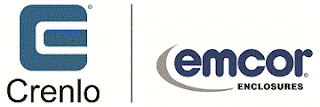– Steven Leidig, manager of enclosure engineering at Crenlo (www.crenlo.com/enclosures), says:
In Part 1 of this post, I discussed how there is often a disconnect between the procurement agent and data center designer. This point is demonstrated by the lack of information often presented to enclosure and rack manufacturers when the purchasing agent places an order. This lack of information often leads to project delays and/or increases in long-term cost of operation due to inefficient design. Thus, I suggest the purchasing agent be able to answer the following seven questions prior to procuring racks for the data center.
1. What is the total weight of equipment being loaded into the enclosure?
Although this information may seem trivial, nearly every design choice of an enclosure is dependent upon weight load capacity, making it one of the most critical pieces of information to provide to the manufacturer. Despite its importance, it’s information that is rarely provided by the buyer.
What buyers often fail to realize is that selection of nearly every component of an enclosure should be based on weight, including casters, levelers, shelves, drawers, sliders, frames, tie-down hardware and anti-tip bases. Often, we don’t feel comfortable recommending a solution until we have the weight load information, because recommending something with insufficient capacity could pose safety concerns and ultimately result in equipment damage. See Figure 2.
2. In what kind of environment will the equipment be installed?
The reliability, performance and efficiency of network equipment are highly dependent upon the equipment’s level of protection against harmful environmental factors. With today’s network equipment no longer limited to phone closets, new environments are posing new protection challenges.
The operating environment heavily influences recommendations on components such as vents, filters and gaskets, as well as the type of materials used and finishes applied to the exterior of an enclosure. What might be right for an A/C room probably wouldn’t be right for a factory floor. As electronics are being put into these new, harsher environments, protection against factors such as water, dust, corrosive agents and emitted radiation are all becoming increasingly common requests.
Failure to base enclosure design on the operating environment can result in decreased lifespan of the equipment. As an example, I’ve seen enclosures installed in industrial environments, where the fans are sucking in dust and debris, circulating it through the equipment and leading to premature failure. With the addition of a filter at the air intake, they could have avoided this problem. This is a simple example, but one that demonstrates the importance of discussing the operating environment with the enclosure manufacturer.
3. What, if any, industry regulations must be met?
In addition to posing new equipment protection concerns, new environments bring new regulatory requirements. Many industries have specific design, manufacturing and installation processes that must be implemented in order to meet these regulations.
Increasingly, enclosure manufacturers must act as regulatory compliance consultants for buyers. I’ve seen situations where our customers have first-rate electrical engineers, but when it comes to meeting the architectural building seismic requirements outlined by the International Building Code, they’re out of their element.
Industry regulations are most commonly in place to ensure there are standards of equipment protection based on environment. For instance, the International Building Code sets forth standards for how enclosures must be installed in areas with seismic concern. The National Electrical Manufacturers Association (NEMA) sets ratings for protection against environmental factors, such as water and dust. The Federal Communications Commission (FCC) has set forth guidelines for shielding of radio frequency interference, and the military has a wide array of standards that apply to specific installation scenarios, such as protection against shock and vibration on naval ships.
Meeting these regulations is often a legal necessity for customers; however, it’s not uncommon for there to be a gap in communication between the buyer and the installer, leading to project delays and increased costs.
On multiple occasions, we’ve had procurement agents or systems integrators purchase enclosures without informing us of the necessity for regulatory compliance. When they get the product, and the installer or building engineer sees it’s not stamped with the necessary code, they are not allowed to install the enclosure. At that point, they have to ship it back, and we start over again, which delays the project and drives up costs. This further demonstrates the necessity of good communication between the person procuring the equipment, the installer and the designer.
Stay tuned for Part 3 of this three-part series from Steven Leidig, manager of enclosure engineering at Crenlo.


